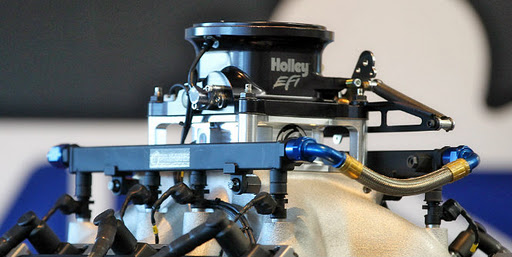By Ryan Hutter
In 2012 NASCAR will introduce Electronic Fuel Injection (EFI) to the Sprint Cup Series, which will replace the Holley 4 barrel carburetors used for the past 40 years. Although EFI is new to NASCAR, it has been around since 1957 when it first became commercially available. It has been in use for sometime in other high profile motor sports such as IndyCar and Formula 1. In fact, some may have never owned a car with a carburetor. That’s because since 1990, every passenger car sold in the US came with electronic fuel injection.After decades of reliable carbureted performance, why make the switch now? A couple of reasons. First, the switch to EFI is part of NASCAR’s “Green Innovation”. They hope it will be as successful as the switch to E15 was in 2011. The Sunoco Green E15 fuel is an ethanol/gasoline blend that yields 6-8 more horsepower than straight gasoline. It also helps employ thousands of Americans who grow and harvest corn used in he production of ethanol.
 |
| Holley Electronic Fuel Injection Photo from NASCAR.com |
We’ve all heard the saying, “Win on Sunday, sell on Monday”. Race fans and consumers identify with drivers and sponsors, especially automobile manufacturers. Chevrolet, Ford, Dodge, and Toyota go to great efforts to make their race cars look and resemble, as closely as possible, the Impala, Fusion, Charger, and Camry you can buy at your local dealership. This brings us to our second reason why NASCAR is making the switch. By adding electronic fuel injection and ethanol blended fuels, NASCAR is trying to appeal to the general public, making the cars more like production vehicles.
So what is the difference between naturally aspirated or carbureted engines and electronically injected engines? EFI and carburetors do essentially the same thing. They provide a fuel and air mixture to the cylinders suitable for combustion. They just do it differently. EFI atomizes fuel for combustion by forcing it through a small nozzle which atomizes the fuel and pumps it into the cylinder. A computer controls how much fuel gets to each cylinder, based on driving conditions. This allows for a more efficient use of fuel. Carburetors use a Venturi to suck fuel into air flowing from the air intake into the fuel manifold and into the cylinders for combustion. Although a mechanical device, the carburetor has proven to be a very reliable and efficient component of NASCAR engines. Today’s carbureted Sprint Cup cars are putting out nearly 900 horsepower and remarkably getting 4.5 to 5 miles per gallon, depending on the track and weather conditions. Despite its reliability, when a carburetor is jetted, or tuned, it is set. It cannot adjust in real time, the amount of fuel the engine needs based on conditions.
 |
| Diagram of a Carbureted Engine Photo from NASCAR.com |
Most modern cars you would buy new today use direct fuel injection systems. As the name suggests, they inject fuel directly into the cylinders. Although NASCAR is adopting EFI, it is technically “throttle body injection“. This allows NASCAR to continue the use of everyone’s beloved restrictor plates. By industry standards, this “new” technology is antiquated and out-dated. Even so, it has attracted young engineering talent that may have been turned off by the old carburetors. The team’s engineering staffs will grow, which could be an indirect cost to the already estimated $22,000 price tag per car.
The idea of EFI has not been without criticism by some drivers. You might recall Brad Keselowski got slapped with a $25,000 fine for sharing his thoughts with reporters and twitter followers earlier this month. However, based on initial results of recent testing, the new configuration should be at least as reliable and efficient as carbureted engines. There’s still work to be done to improve the throttled response feel for the driver. I believe the engineers will work this out. Heck, even my old 2001 Corvette has a fly by wire throttle, and that seems to work just fine.
Bottom line, NASCAR has too much to lose for this to fail. They have done the engineering and development to make this work. Track testing is ongoing and should be ready to go come late January/early February. If you ask me, a bigger issue than EFI is the tandem drafting. Drivers don’t like it and as a fan it is not what I pay to see. Let’s get that fixed. EFI is a non issue.
Many thanks and credit to Mark Aumann, NASCAR.COM and his article “NASCAR takes ‘really big step’ with fuel injection“.
